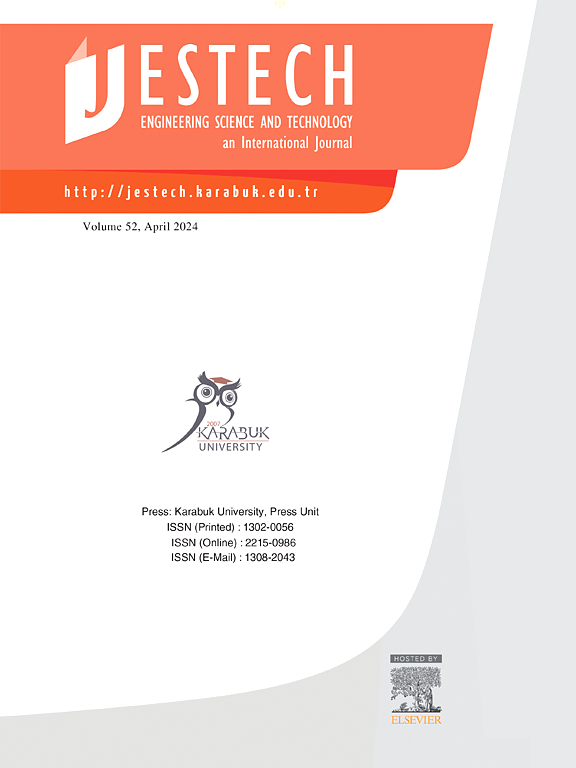Optimization of heat transfer and entropy for Maxwell dusty fluid: Significance of Lorentz force and variable viscosity
IF 5.1
2区 工程技术
Q1 ENGINEERING, MULTIDISCIPLINARY
Engineering Science and Technology-An International Journal-Jestech
Pub Date : 2025-07-11
DOI:10.1016/j.jestch.2025.102129
引用次数: 0
Abstract
Dusty fluids are an indispensable source of efficient heat production with many applications in many scientific and technical fields. The incorporation of dust nanoparticles, characterized by their enhanced thermal properties, broadens the range of potential applications to include complex domains such as chemical and mechanical engineering and cutting-edge technological environments. The main aim of this investigation is to explore the momentum and thermal transfer properties of a magnetohydrodynamics Maxwell nanofluid passing through an inclined surface while carrying conductive dust particles as a volume fraction. This study provides a means to optimize thermal systems in engineering and technological settings by examining dusty Maxwell nanofluids under magnetic and convective circumstances. The problem is theoretically simulated by incorporating the mixed convective situation and magnetic influence. Furthermore, analyzing the Bejan number and entropy generation reveals the stream’s delicate aspects. Using similarity transformation, the heat transfer and fluid flow controlling equations are converted into ordinary differential equations that are nonlinear, which are solved numerically by a shooting approach. The effects of dimensionless controlling factors on flow velocity, Bejan number, entropy generation rate, and thermal profiles are examined and shown using graphics. Additionally, the Nusselt number and friction factor are computed. The results demonstrated that the mixed convection parameter and the dusty-fluid interaction variable increase the entropy production and the Bejan number. It is also explored that the velocity and thermal profile exhibit distinguishing behavior for increasing magnetic variables. The Bejan number and the entropy generation rate show an increasing trend as the Maxwell fluid parameter rises. The improved elastic effects of the Maxwell fluid, which increase internal friction and heat transfer irreversibility, cause this rise. Compared to previous studies, the results obtained showed an elevated level of homogeneity and precision.
麦克斯韦尘流体传热和熵的优化:洛伦兹力和变粘度的意义
含尘流体是一种不可缺少的高效产热源,在许多科学和技术领域都有许多应用。灰尘纳米颗粒的加入,其特点是其增强的热性能,扩大了潜在的应用范围,包括复杂的领域,如化学和机械工程和尖端技术环境。本研究的主要目的是探索磁流体动力学麦克斯韦纳米流体在携带导电粉尘颗粒(体积分数)通过倾斜表面时的动量和传热特性。本研究通过在磁性和对流环境下检测麦克斯韦纳米流体,为优化工程和技术环境中的热系统提供了一种方法。结合混合对流情况和磁场影响,对该问题进行了理论模拟。此外,分析贝让数和熵的产生揭示了流的微妙方面。利用相似变换将传热方程和流体流动控制方程转化为非线性常微分方程,采用射击法进行数值求解。研究了无量纲控制因素对流速、贝让数、熵产率和热分布的影响,并用图形表示。此外,还计算了努塞尔数和摩擦系数。结果表明,混合对流参数和粉尘-流体相互作用变量增加了熵产和贝让数。还探讨了速度和热剖面随着磁变量的增加而表现出不同的行为。Bejan数和熵产率随麦克斯韦流体参数的增大而增大。麦克斯韦流体弹性效应的改善,增加了内摩擦和传热的不可逆性,导致了这一上升。与以往的研究相比,获得的结果显示出更高的均匀性和精度。
本文章由计算机程序翻译,如有差异,请以英文原文为准。
求助全文
约1分钟内获得全文
求助全文
来源期刊

Engineering Science and Technology-An International Journal-Jestech
Materials Science-Electronic, Optical and Magnetic Materials
CiteScore
11.20
自引率
3.50%
发文量
153
审稿时长
22 days
期刊介绍:
Engineering Science and Technology, an International Journal (JESTECH) (formerly Technology), a peer-reviewed quarterly engineering journal, publishes both theoretical and experimental high quality papers of permanent interest, not previously published in journals, in the field of engineering and applied science which aims to promote the theory and practice of technology and engineering. In addition to peer-reviewed original research papers, the Editorial Board welcomes original research reports, state-of-the-art reviews and communications in the broadly defined field of engineering science and technology.
The scope of JESTECH includes a wide spectrum of subjects including:
-Electrical/Electronics and Computer Engineering (Biomedical Engineering and Instrumentation; Coding, Cryptography, and Information Protection; Communications, Networks, Mobile Computing and Distributed Systems; Compilers and Operating Systems; Computer Architecture, Parallel Processing, and Dependability; Computer Vision and Robotics; Control Theory; Electromagnetic Waves, Microwave Techniques and Antennas; Embedded Systems; Integrated Circuits, VLSI Design, Testing, and CAD; Microelectromechanical Systems; Microelectronics, and Electronic Devices and Circuits; Power, Energy and Energy Conversion Systems; Signal, Image, and Speech Processing)
-Mechanical and Civil Engineering (Automotive Technologies; Biomechanics; Construction Materials; Design and Manufacturing; Dynamics and Control; Energy Generation, Utilization, Conversion, and Storage; Fluid Mechanics and Hydraulics; Heat and Mass Transfer; Micro-Nano Sciences; Renewable and Sustainable Energy Technologies; Robotics and Mechatronics; Solid Mechanics and Structure; Thermal Sciences)
-Metallurgical and Materials Engineering (Advanced Materials Science; Biomaterials; Ceramic and Inorgnanic Materials; Electronic-Magnetic Materials; Energy and Environment; Materials Characterizastion; Metallurgy; Polymers and Nanocomposites)
 求助内容:
求助内容: 应助结果提醒方式:
应助结果提醒方式:


